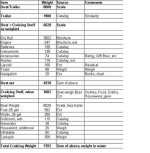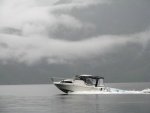Hello Bob, thank you for responding.
First of all, it is not correct that the Marinaut is a flat bottom boat. Take a close look at the hull photos in Les Lampan's Facebook account. It even has a keel of sorts, and maintains a V, albeit slight, until it reaches the stern. As you stated to me over a year ago, "There is slightly more deadrise <in the Marinaut> than the C-Dory, and slightly more reverse chine." And you said that these characteristics "... tend to give... slightly more fuel consumption, but a slightly better ride..." Simply stated, the Marinaut is a great riding boat. An absolute, undeniable fact for me is that she averages 4.7 mpg in real world conditions of dividing total miles traveled by total gallons consumed. These results have been consistent for two years. This does not, however, negate what you stated. Perhaps the hull design is not as efficient than a C-Dory, but has a slightly better ride, and the reason for the Marianut's slightly better fuel efficiency could be that she weighs less than a comparably equipped CD 22. We all know that overall weight is a major factor I fuel consumption.
As for my feeling that 35 mph is too fast, that is my opinion. I am a conservative person who wants to feel that I am in total control. It is not just my life for which I am responsible, but also my passengers. I feel in total control below 30 mph; it is as simple as that. Others may not feel the same as I do. If the water was like glass, than 30 mph would probably be O.K., because there is a good bite to the water. However, she is not a deep V built for speed. Further, the C-Dory's and Marinaut ride low in the water, and we don't have the visibility of a Rosoborough, Ranger Tug, or many production boats in our size range. Traveling more slowly provides greater reaction time to evade objects in the water that are difficult to see.
When I state that I can't make forward progress in greater than 3.5 head seas, I'm talking about significant wave height -- not maximum wave height. At 3.5 feet significant wave height it is not uncommon to experience 6 foot maximum waves. Many of you are making an assumption that seamanship is the answer to my issue such as better throttle adjustments, quartering into the waves, and etc. It's frustrating, because I can't quite figure this out, which is why I am seeking help.
Imagine being in 3.5 footers at significant wave height with 4 to 5 foot maximum waves, and in shallow water. Winds are at 15 to 20 knots, and are coming out of the WNW. Due to the actions of the tides in the Sound, the current from the Connecticut River, 4 knot tidal moves coming out of the south from Plum Gut, the fetch, and wind changes, there is ABSOLUTELY NO DIRECTION ON THE COMPASS that you can point your boat to gain relief. Unless you want to tear the boat apart due to unnecessary roughness, you can barely make 3 knots. This is what it can be like in Central Long Island Sound, and we were in these conditions twice this year. I keep telling everyone that this year was vastly different from my other 5 years on the Sound. There is no way that any of you in a CD 22 Cruiser is going to make even 7 knots in the conditions I describe. In my movie, the 4 footer shown was an occasional maximum wave height, and significant wave height was around 2 to 2.5 feet. We actually made good forward progress -- at least 11 knots -- in these conditions, which you can see in the film. We could have traveled faster, but I don't like to punish my boat and its occupants. The reason that you can't clearly see the other Marinaut in the distance, is because he left me in the dust! The only real difference between our two boats is his Permatrim. When he passed me, his bow looked up, but not excessively. I really get what Bob is saying, so something else more subtle may be at play here.
As for danger in the above confused seas conditions -- if you are not alert, you can be broadsided by a big wave coming from the wrong direction, or you can be traveling too fast when such a wave hits you head on, or from the quarter, which can cause your boat to drop like a lead weight after that fast moving wave falls out from underneath you. That's why I am more than amused when people suggest they can go fast in those conditions. I would love to witness that some day, but from a solid vantage point on the shore through binoculars.
Regarding my comment that my boat is evenly balanced, I was not making a comparison between my boat and a CD 22. Let me put it in my terms: some people have boats that have greater weight in the stern making it difficult to get the bow down. So they have to shift their weight around in the boat. That was the case with my sold CD16 Cruiser. I had to bring a lot of weight forward to even the trim. Thanks to Dave's foresight, those saddle tanks do a great deal to keep the Marinaut nicely trimmed. Frankly, the boat handles so well, that in most conditions, engine trim is enough, but she does benefit from trim tabs, and we need them to hold the bow down at slower planing speeds.
I don't exaggerate. Earlier this year, I was traveling 15 mph into 3 foot head seas maximum wave height. Every third wave was 3 feet, with average wave height 2 to 2.5 feet. I had the trim tabs and engine trim down. She travelled smoothly. When the bow is forced down like that, a lot of water is displaced, and we got a lot of spray hitting the windshield. So we traveled like that for an hour thinking that we were going to make it to our destination in relative comfort. Once we reached Branford, significant wave height reached 3.5 to 4 feet, with 5 foot maximums. Then, while traveling at only 4 knots, a 6 or 7 footer ( as best I could estimate, because it looked level with my roof) sped into us, lifted us into the air, and dropped us like a hot potato. It was the biggest drop I have ever experienced in our boat. This was a rouge wave of sorts, probably caused by changes in bottom depth. Knowing that the conditions changed, I realized, as most prudent boaters would do, that I could not make the 30 miles to my destination. I quartered into the wave troughs going north, and then traveled east with following seas. In these conditions I exceeded 15 mph and travelled smoothly. If you look very carefully at the Marinaut's bow, you can see that it can easily slice through 3 to 3.5 maximum waves at a high rate of speed if you can keep the bow down. But when I make this type of comment, I usually make the caveat that the wave period as well as other factors are at work. So to universally state that the Marinaut can handle all 3 footers at high speed would be ludicrous of me to state.
Finally, I have a theory why Steve's Marinaut with his Permatrim installed went speeding past me. His Permatrim allowed him, without use of excessive trim, to keep his bow down enough to travel on top of the wave crests at around 10 to 12 knots. Not having Permatrim on my boat, 10 knots is not enough for trim tabs alone to keep the bow from bouncing up. To prevent pitch poling, I was forced to go slower. And as Bill commented, trim tabs lose their effectiveness at very slow speeds. Does this make sense?
Rich



